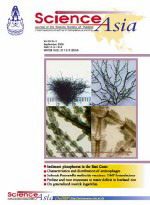ThaiScience
ThaiScience
SCIENCE ASIA
Volume 46, No. 01, Month FEBRUARY, Year 2020, Pages 59 - 64
Investigating the oxidation behavior of carbon steel in fire scene a new method for fire investigations
Hao Hong, Dongbai Xie, Shuwang Duo, Wen Wang
Abstract Download PDF
A major component of fire investigation is tracking the cause of fire, finding of which help to strengthen the physical evidence, especially in case of arson with accelerants. When metallic substances are exposed to fire at high temperature, they undergo oxidation. Accelerants at the fire scene impart some oxidative characteristics on metallic materials. For instance oxides and substrates found on metal surfaces provide valuable information for determining the characteristics of fire, such as exposure temperature, duration and involvement of a liquid accelerant. In this study, we investigated the oxidation behavior of carbon steel at high temperature in a simulated flame environment using ethanol combustion. After oxidation, the morphological and microstructural features of the samples were characterized by observation, scanning probe microscope, X-ray diffractions and scanning electron microscopy with energy-dispersive spectroscopy analysis. The results showed that elemental carbon was deposited on the samples surface, which were ascribed to the incomplete combustion of ethanol. An oxide with a mesh-like pattern appeared on the samples, which was ascribed to the complex oxidation conditions of the fire scene. The properties of the oxides were strongly dependent on the oxidation duration, temperature and atmosphere. These results provide reference information for determining the presence of combustion accelerants at the fire scene.
Keywords
fire investigation, arson, carbon steel, ethanol, oxidationSCIENCE ASIA
Published by : The Science Society of Thailand
Contributions welcome at : http://www.scienceasia.org/
